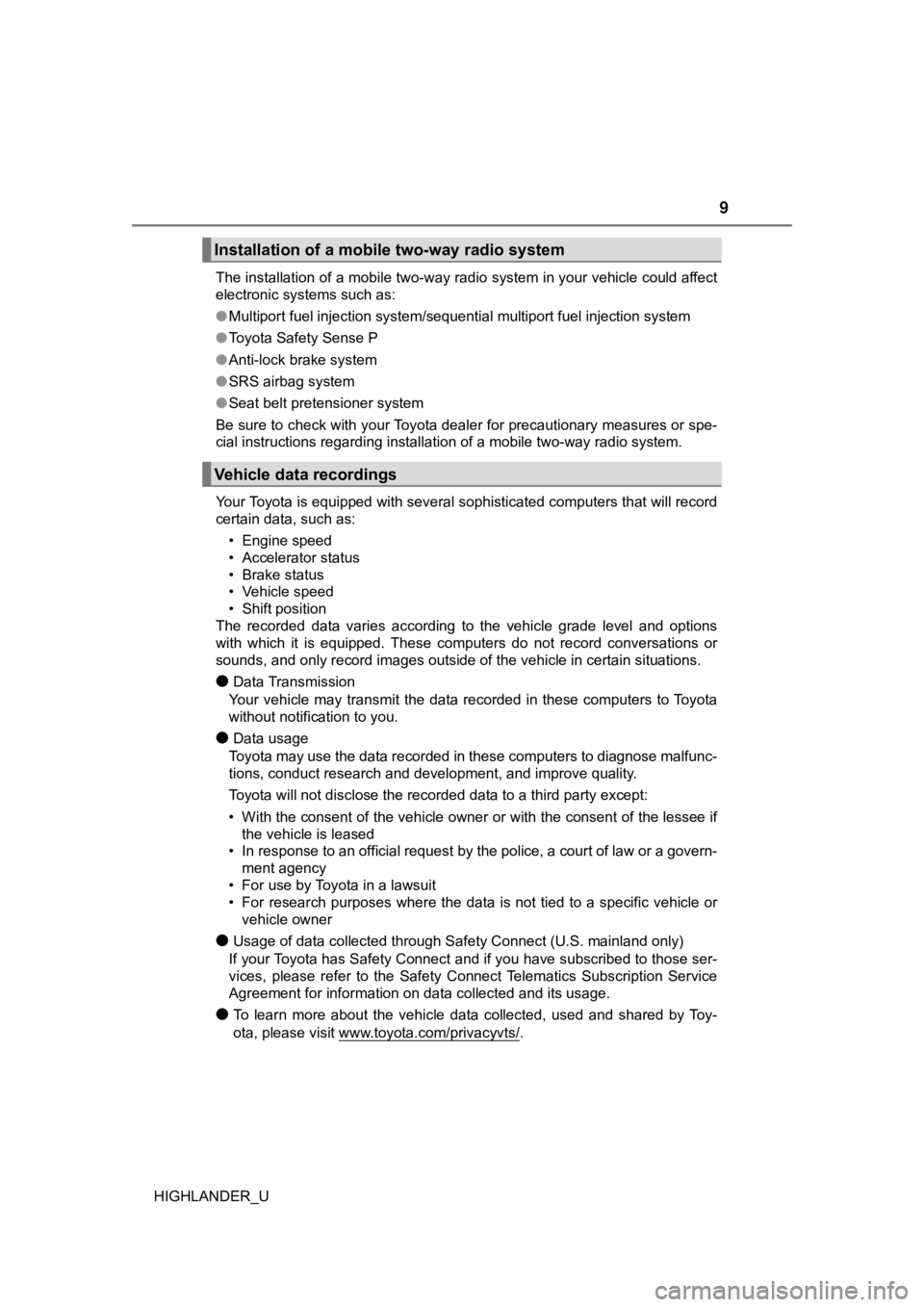radio TOYOTA HIGHLANDER 2019 Owners Manual (in English)
[x] Cancel search | Manufacturer: TOYOTA, Model Year: 2019, Model line: HIGHLANDER, Model: TOYOTA HIGHLANDER 2019Pages: 732, PDF Size: 14.44 MB
Page 4 of 732

TABLE OF CONTENTS4
HIGHLANDER_U5-1. Basic Operations
Audio system types ........... 356
Entune Audio..................... 357
Steering wheel audio switches ................ 360
AUX Port/USB Port ........... 361
Basic audio operations ...... 362
5-2. Setup Setup menu ....................... 364
General settings ................ 365
Audio settings.................... 366
Display settings ................. 367
Voice settings .................... 368
5-3. Using Entune Audio Selecting the audio source ................... 369
List screen operation ......... 370
Optimal use of Entune Audio .................. 372
5-4. Using the radio Radio operation ................. 373
5-5. Playing an audio CD and MP3/WMA/AAC discs
CD player operation .......... 375
5-6. Using an external device
Listening to an iPod........... 381
Listening to a USB memory device................ 385
Using the AUX port ........... 389 5-7. Connecting Bluetooth
®
Preparations to use
wireless
communication ................ 390
Registering a Bluetooth
®
audio player for the
first time ........................... 394
Registering a Bluetooth
®
phone for the first time..... 395
Registering a Bluetooth
®
device .............................. 396
Connecting a Bluetooth
®
device .............................. 398
Displaying a Bluetooth
®
device details................... 400
Detailed Bluetooth
®
system settings................ 401
5-8. Bluetooth
® Audio
Listening to Bluetooth®
Audio ............................... 402
5-9. Bluetooth
® phone
Using a Bluetooth®
Phone .............................. 403
Making a call...................... 405
Receiving a call ................. 408
Speaking on the phone...... 409
Bluetooth
® phone
message function ............ 412
Using the steering wheel switches ................ 416
Bluetooth
® phone
settings ............................ 417
Contact/Call History Settings ........................... 418
What to do if... (Troubleshooting) ............ 427
5Audio system
Page 9 of 732

9
HIGHLANDER_UThe installation of a mobile two-way radio system in your vehic
le could affect
electronic systems such as:
● Multiport fuel injection system/sequential multiport fuel injection system
● Toyota Safety Sense P
● Anti-lock brake system
● SRS airbag system
● Seat belt pretensioner system
Be sure to check with your Toyota dealer for precautionary meas ures or spe-
cial instructions regarding instal lation of a mobile two-way radio system.
Your Toyota is equipped with several sophisticated computers th at will record
certain data, such as:
• Engine speed
• Accelerator status
• Brake status
• Vehicle speed
• Shift position
The recorded data varies according to the vehicle grade level and options
with which it is equipped. These computers do not record conver sations or
sounds, and only record images outside of the vehicle in certai n situations.
●Data Transmission
Your vehicle may transmit the data recorded in these computers to Toyota
without notification to you.
●Data usage
Toyota may use the data recorded in these computers to diagnose malfunc-
tions, conduct research and development, and improve quality.
Toyota will not disclose the recorded data to a third party exc ept:
• With the consent of the vehicle owner or with the consent of the lessee if the vehicle is leased
• In response to an official request by the police, a court of l aw or a govern-
ment agency
• For use by Toyota in a lawsuit
• For research purposes where the data is not tied to a specific vehicle or
vehicle owner
●Usage of data collected through Safety Connect (U.S. mainland o nly)
If your Toyota has Safety Connect and if you have subscribed to those ser-
vices, please refer to the Safety Connect Telematics Subscription Service
Agreement for information on data collected and its usage.
●To learn more about the vehicle data collected, used and shared by Toy-
ota, please visit www.toyota.com/privacyvts/
.
Installation of a mobile two-way radio system
Vehicle data recordings
Page 47 of 732

471-1. For safe use
1
For safety and security
HIGHLANDER_U
WARNING
■SRS airbag precautions
● If the areas where the SRS airbags are stored, such as the steering wheel
pad and front and rear pillar garnishes, are damaged or cracked , have
them replaced by your Toyota dealer.
● Do not place anything, such as a cushion, on the front passenger’s seat.
Doing so will disperse the passenger’s weight, which prevents t he sensor
from detecting the passenger’s weight properly. As a result, th e SRS front
airbags for the front passenger may not deploy in the event of a collision.
■ Modification and disposal of SRS airbag system components
Do not dispose of your vehicle or perform any of the following modifications
without consulting your Toyota dealer. The SRS airbags may malfunction or
deploy (inflate) accidentally, causing death or serious injury.
● Installation, removal, disassembly and repair of the SRS airbag s
● Repairs, modifications, removal or replacement of the steering wheel,
instrument panel, dashboard, seats or seat upholstery, front, s ide and rear
pillars or roof side rails
● Repairs or modifications of the front fender, front bumper or s ide of the
occupant compartment
● Installation of a grille guard (bull bars, kangaroo bar, etc.), snow plows,
winches or roof luggage carrier
● Modifications to the vehicle’s suspension system
● Installation of electronic devices such as mobile two-way radio s and CD
players
● Modifications to your vehicle for a person with a physical disa bility
Page 85 of 732

851-2. Emergency assistance
1
For safety and security
HIGHLANDER_U
Important! Read this information before using Safety Connect.
■Exposure to radio frequency signals
The Safety Connect system installed in your vehicle is a low-po wer
radio transmitter and receiver. I t receives and also sends out radio
frequency (RF) signals.
In August 1996, the Federal Communications Commission (FCC)
adopted RF exposure guidelines with safety levels for mobile wi re-
less phones. Those guidelines are consistent with the safety stan-
dards previously set by the following U.S. and international
standards bodies.
● ANSI (American National Stand ards Institute) C95.1 [1992]
● NCRP (National Council on Radi ation Protection and Measure-
ment) Report 86 [1986]
● ICNIRP (International Commission on Non-Ionizing Radiation
Protection) [1996]
Those standards were based on comprehensive and periodic eval-
uations of the relevant scienti fic literature. Over 120 scientists, engi-
neers, and physicians from unive rsities, and government health
agencies and industries reviewed the available body of research to
develop the ANSI Standard (C95.1).
The design of Safety Connect complies with the FCC guidelines i n
addition to those standards.
■ Certification for Safety Connect
FCC ID: LHJ-TVN
NOTE:
This device complies with Part 15 of the FCC Rules. Operation i s subject to
the following two conditions: (1) This device may not cause har mful interfer-
ence, and (2) this device must accept any interference received, including
interference that may cause undesired operation.
FCC WARNING:
Changes or modifications not expressly approved by the party re sponsible for
compliance could void the user's authority to operate the equip ment.
Safety information for Safety Connect
Page 87 of 732

871-3. Theft deterrent system
1
For safety and security
HIGHLANDER_U
■System maintenance
The vehicle has a maintenance-free type engine immobilizer syst em.
■ Conditions that may cause the system to malfunction
●If the grip portion of the key is in contact with a metallic ob ject
● If the key is in close proximity to or touching a key to the security system
(key with a built-in transponder chip) of another vehicle
■ Certification for the engine immobilizer system
For vehicles sold in the U.S.A.
FCC ID: MOZRI-42BTY FCC ID: NI4TMIMB-3
This device complies with part 15 of the FCC Rules. Operation is subject to
the following two conditions: (1) This device may not cause har mful interfer-
ence; and (2) This device must accept any interference received, including
interference that may cause undesired operation.
Changes or modifications not expressly approved by the party re sponsible for
compliance could void the user's authority to operate the equip ment.
For vehicles sold in Canada
This device complies with Industry Canada licence-exempt RSSs. Operation
is subject to the following two conditions: (1) This device may not cause inter-
ference; and (2) This device must accept any interference, incl uding interfer-
ence that may cause undesired operation of the device.
Le présent appareil est conforme aux CNR d'lndustrie Canada app licables
aux appareils radio exempts de licence. L'exploitation est auto risée aux deux
conditions suivantes: (1) l'appareil ne doit pas produire de br ouillage; (2) l'util-
isateur de l'appareil doit accepter tout brouillage radioélectr ique subi, même
si le brouillage est susceptible d'en compromettre le fonctionn ement.
NOTICE
■To ensure the system operates correctly
Do not modify or remove the system. If modified or removed, the proper
operation of the system cannot be guaranteed.
Page 117 of 732

1173-1. Key information
3
Operation of each component
HIGHLANDER_U■
When required to leave the vehicle’s key with a parking attenda nt (vehi-
cles with a smart key system)
Lock the glove box as circumstances demand. (P. 467)
Remove the mechanical key for your own use and provide the attendant with
the electronic key only.
■ If you lose your keys
New genuine keys can be made by your Toyota dealer using the ot her key
(vehicles without a smart key system) or the other mechanical k ey (vehicles
with a smart key system) and the key number stamped on your key number
plate. Keep the plate in a safe place such as your wallet, not in the vehicle.
■ When riding in an aircraft
When bringing a key with wireless remote control function onto an aircraft,
make sure you do not press any buttons on the key while inside the aircraft
cabin. If you are carrying the key in your bag etc., ensure tha t the buttons are
not likely to be pressed accidentally. Pressing a button may cause the key to
emit radio waves that could interfere with the operation of the aircraft.
■ Conditions affecting operation
Vehicles without a smart key system
The wireless remote control function may not operate normally i n the follow-
ing situations:
● When the wireless key battery is depleted
● Near a TV tower, electric power plant, gas station, radio stati on, large dis-
play, airport or other facility that generates strong radio wav es or electrical
noise
● When carrying a portable radio, cellular phone or other wireles s communi-
cation device
● When multiple wireless keys are in the vicinity
● When the wireless key is in contact with, or is covered by a me tallic object
● When a wireless key (that emits radio waves) is being used near by
● When the wireless key has been left near an electrical applianc e such as a
personal computer
● If window tint with a metallic content or metallic objects are attached to the
rear window
Vehicles with a smart key system
P. 150
Page 118 of 732

1183-1. Key information
HIGHLANDER_U■
Key battery depletion
Vehicles without a smart key system
If the wireless remote control function does not operate, the b attery may be
depleted. Replace the battery when necessary. ( P. 551)
Vehicles with a smart key system
● The standard battery life is 1 to 2 years.
● If the battery becomes low, an alarm will sound in the cabin wh en the engine
stops. ( P. 607)
● As the electronic key always receives radio waves, the battery will become
depleted even if the electronic key is not used. The following symptoms indi-
cate that the electronic key battery may be depleted. Replace the battery
when necessary. ( P. 551)
• The smart key system or the wireless remote control does not o perate.
• The detection area becomes smaller.
• The LED indicator on the key surface does not turn on.
● To avoid serious deterioration, do not leave the electronic key within 3 ft. (1
m) of the following electrical appliances that produce a magnet ic field:
•TVs
• Personal computers
• Cellular phones, cordless phones and battery chargers
• Recharging cellular phones or cordless phones
• Table lamps
• Induction cookers
■ When the key battery is fully depleted
P. 551
■ Confirmation of the registered key number (vehicles with a smar t key
system)
The number of electronic keys already registered to the vehicle can be con-
firmed. Ask your Toyota dealer for details.
■ If a wrong key is used (vehicles with a smart key system)
The key cylinder rotates freely to isolate inside mechanism.
■ Customization
Settings (e.g. wireless remote control system) can be changed.
(Customizable features: P. 682)
Page 119 of 732

1193-1. Key information
3
Operation of each component
HIGHLANDER_U■
Certification for wireless remote control (vehicles without a smart key
system)
TRW Automotive
Automobile Entry/Security Transmitter
Model: 226624-101, 226624-102
FCC ID: GQ4-52T
IC: 1470A-33T
Auto Alarm/Security system Receiver
Model: 230433
FCC ID: GQ4-45R
CAN RSS-GEN/CNR-GEN
MADE IN U.S.A.
This device complies with Part 15 of the FCC Rules and with Ind ustry Canada
license-exempt RSS standard(s). Operation is subject to the following two
conditions:
(1) This device may not cause harmful interference, and
(2) This device must accept any interference received, includin g interference
that may cause undesired operation of the device.
Le présent appareil est conforme aux CNR d’Industrie Canada app licables
aux appareils radio exempts de licence. L’exploitation est auto risée aux deux
conditions suivantes:
(1) l’appareil ne doit pas produire de brouillage, et
(2) l’utilisateur de l’appareil doit accepter tout brouillage radioélectrique subi,
même si le brouillage est susceptible d’en compromettre le fonctionnement.
WARNING: Changes or modifications not expressly approved by TRW Auto-
motive U.S. LLC could void the user's authority to operate the equipment.
■ Certification for wireless remo te control (vehicles with a smart key sys-
tem)
P. 153
Page 120 of 732

1203-1. Key information
HIGHLANDER_U
NOTICE
■To prevent key damage
● Do not drop the keys, subject them to strong shocks or bend them.
● Do not expose the keys to high temperatures for long periods of time.
● Do not get the keys wet or wash them in an ultrasonic washer et c.
● Do not attach metallic or magnetic materials to the keys or pla ce the keys
close to such materials.
● Do not disassemble the keys.
● Do not attach a sticker or anything else to the surface of the key with a
wireless remote control function.
● Vehicles with a smart key system: Do not place the keys near ob jects that
produce magnetic fields, such as TVs, audio systems and inducti on cook-
ers, or medical electrical equipment, such as low-frequency the rapy equip-
ment.
■ Carrying the electronic key on your person (vehicles with a sma rt key
system)
Carry the electronic key 3.9 in. (10 cm) or more away from elec tric appli-
ances that are turned on. Radio waves emitted from electric app liances
within 3.9 in. (10 cm) of the electronic key may interfere with the key, caus-
ing the key to not function properly.
■ In case of a smart key system malfunction or other key-related prob-
lems (vehicles with a smart key system)
Take your vehicle with all the electronic keys provided with yo ur vehicle to
your Toyota dealer.
■ When an electronic key is lost (vehicles with a smart key system)
If the electronic key remains lost, the risk of vehicle theft i ncreases signifi-
cantly. Visit your Toyota dealer immediately with all remaining electronic
keys that was provided with your vehicle.
Page 143 of 732

1433-2. Opening, closing and locking the doors
3
Operation of each component
HIGHLANDER_U
■Luggage compartment light
P. 132
■ The glass hatch can be opened when
The back door is closed.
■ Opening and closing the glass hatch
●Open the glass hatch slowly and carefully.
● Make sure that the rear window wiper is switched off.
● Do not rotate the rear wiper arm when the glass hatch is open. (If the rear
wiper arm is rotated, turn the wiper switch on after closing th e glass hatch.
The rear wiper arm will return to the correct position automati cally after
operating once.)
● Make sure that the back door is closed before closing the glass hatch.
■ After closing the glass hatch
Check that the glass hatch is firmly closed. If it is not firmly closed, the rear
window wiper and washer will not operate correctly.
■ Function to prevent the glass hatch being locked with the elect ronic key
inside (vehicles with a smart key system)
● When all doors are locked, closing the glass hatch with the ele ctronic key
left inside the luggage compartment will sound an alarm.
In this case, the glass hatch can be opened by pressing the gla ss hatch
opener.
● If the spare electronic key is put in the luggage compartment w ith all the
doors locked, the key confinement prevention function will acti vate and the
glass hatch can be opened. In order to prevent theft, take all electronic keys
with you when leaving the vehicle.
● If the electronic key is put in the luggage compartment with al l the doors
locked, the key may not be detected depending on the location o f the key
and the surrounding radio wave conditions. In this case, the key confine-
ment prevention function cannot be activated, causing the doors to lock
when the glass hatch is closed. Make sure to check where the ke y is before
closing the glass hatch.